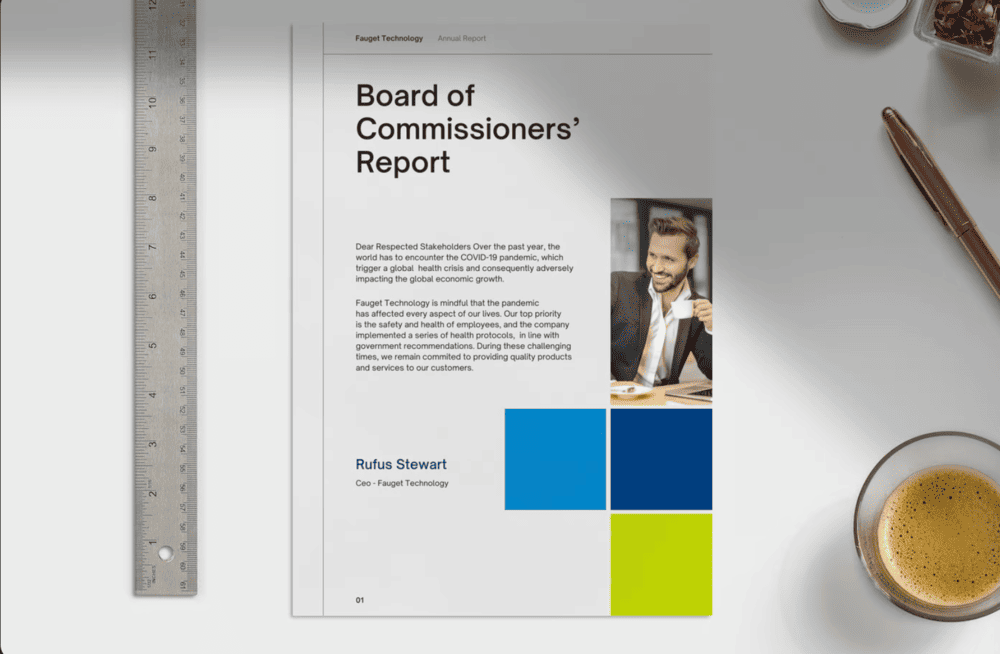Laporan tahunan bukan sekadar dokumen formal; ini adalah gambaran lengkap tentang kinerja, tujuan, dan strategi perusahaan dalam satu tahun terakhir. Untuk membangun kepercayaan dengan pemangku kepentingan, menarik investor, dan menjaga transparansi, menyusun laporan tahunan yang menarik dan akurat adalah hal yang penting. Tapi, sebenarnya apa saja yang harus ada dalam laporan tahunan yang efektif?
Dalam blog ini, kita akan membahas komponen penting dalam laporan tahunan perusahaan, kenapa itu penting, dan bagaimana elemen-elemen tersebut dapat memengaruhi persepsi bisnis kamu. Baik kamu sedang menyusun laporan tahunan pertama atau ingin memperbaiki laporan yang sudah ada, memahami elemen-elemen ini sangat penting untuk menciptakan dokumen profesional dan berpengaruh.
- 1. Ringkasan Eksekutif: Membuka dengan Kesan yang Kuat
- 2. Laporan Keuangan: Inti dari Transparansi
- 3. Ikhtisar Bisnis dan Sorotan Utama
- 4. Surat dari CEO: Membangun Koneksi Personal
- 5. Tren Pasar dan Analisis Industri
- 6. Keberlanjutan dan Tanggung Jawab Sosial Perusahaan (CSR)
- 7. Manajemen Risiko dan Tantangan
- 8. Prospek Masa Depan dan Tujuan Strategis
- Kenapa Laporan Tahunan yang Komprehensif Itu Penting
- Bagaimana Noethera Bisa Membantu dengan Laporan Tahunan Kamu
- Kesimpulan
1. Ringkasan Eksekutif: Membuka dengan Kesan yang Kuat

Ringkasan eksekutif adalah bagian pembuka dalam laporan tahunan yang memberikan pembaca gambaran singkat tentang kinerja perusahaan serta pencapaian utama dalam setahun terakhir. Bagian ini sangat penting karena menetapkan nada untuk seluruh dokumen, memberikan pemangku kepentingan ringkasan tentang apa yang akan mereka temukan di dalamnya.
Ringkasan eksekutif yang efektif harus menjelaskan secara singkat pencapaian utama, tantangan besar, dan tujuan strategis di masa depan. Anggap ini seperti trailer film—singkat, menarik, dan penuh informasi. Dengan pembukaan yang kuat, kamu dapat menarik perhatian pembaca dan membuat mereka ingin membaca lebih jauh.
2. Laporan Keuangan: Inti dari Transparansi

Transparansi keuangan adalah inti dari setiap laporan tahunan yang sukses. Investor dan pemangku kepentingan mengandalkan data ini untuk menilai stabilitas, potensi pertumbuhan, dan profitabilitas perusahaan. Bagian ini biasanya mencakup:
- Laporan Laba Rugi : Menunjukkan pendapatan, pengeluaran, dan laba bersih.
- Neraca Keuangan : Menyajikan aset, kewajiban, dan ekuitas perusahaan.
- Laporan Arus Kas : Menguraikan pemasukan dan pengeluaran kas untuk menunjukkan likuiditas dan efisiensi operasional.
Agar data keuangan lebih mudah dipahami, banyak perusahaan menambahkan grafik, diagram, dan visualisasi data. Elemen-elemen ini membantu pembaca memahami informasi kompleks dengan cepat dan membandingkan tren dari waktu ke waktu.
3. Ikhtisar Bisnis dan Sorotan Utama
Laporan tahunan perusahaan harus memberikan gambaran lengkap tentang bisnis, operasional, dan arah strategisnya. Bagian ini sering mencakup misi, visi, dan nilai-nilai perusahaan yang memberikan konteks untuk kinerja dan tujuan masa depan.
Selain menjelaskan operasi inti perusahaan, bagian ini juga harus menyoroti pencapaian penting, peluncuran produk baru, atau ekspansi pasar yang terjadi selama periode laporan. Pencapaian ini tidak hanya menunjukkan pertumbuhan tetapi juga membuktikan kemampuan perusahaan untuk beradaptasi dan berinovasi di pasar yang kompetitif.
4. Surat dari CEO: Membangun Koneksi Personal
Surat dari CEO adalah elemen wajib dalam setiap laporan tahunan, memberikan sudut pandang personal dan otoritatif tentang kinerja perusahaan. Ditulis dengan nada yang langsung dan menarik, bagian ini menawarkan wawasan tentang kesuksesan, tantangan, dan strategi masa depan perusahaan.
Surat yang baik dari CEO secara langsung berbicara kepada pemangku kepentingan, menciptakan rasa kepercayaan dan transparansi. Surat ini sering menyebutkan kontribusi utama dari karyawan, mitra, dan pelanggan, sambil menyoroti komitmen perusahaan untuk mencapai tujuannya di masa depan.
5. Tren Pasar dan Analisis Industri
Menambahkan bagian tentang tren pasar dan analisis industri memberikan kedalaman pada laporan tahunan kamu. Bagian ini menempatkan perusahaan dalam konteks pasar yang lebih luas, menunjukkan pemahaman kamu tentang dinamika industri dan strategi untuk memanfaatkan peluang.
Sebagai contoh, jika perusahaan kamu bergerak di sektor teknologi, kamu bisa membahas tren seperti perkembangan AI, tantangan keamanan siber, atau perubahan perilaku konsumen. Analisis ini tidak hanya meningkatkan nilai laporan tetapi juga meyakinkan pemangku kepentingan bahwa perusahaan proaktif dan visioner.
6. Keberlanjutan dan Tanggung Jawab Sosial Perusahaan (CSR)
Di dunia bisnis saat ini, pemangku kepentingan semakin menghargai perusahaan yang memprioritaskan keberlanjutan dan tanggung jawab sosial. Menyertakan bagian khusus tentang inisiatif CSR dan dampak lingkungan menunjukkan bahwa perusahaan kamu berkomitmen untuk memberikan perubahan positif.
Bagian ini bisa mencakup upaya untuk mengurangi emisi karbon, mendukung komunitas lokal, atau menerapkan praktik sourcing yang etis. Mendukung inisiatif ini dengan data yang terukur—seperti pengurangan konsumsi energi atau dana yang disumbangkan untuk tujuan sosial—akan menambah kredibilitas klaim kamu.
7. Manajemen Risiko dan Tantangan
Tidak ada perjalanan bisnis yang tanpa hambatan, dan membahas tantangan secara terbuka dalam laporan tahunan menunjukkan kejujuran dan tanggung jawab. Bagian manajemen risiko harus mengidentifikasi tantangan potensial yang dihadapi selama tahun berjalan dan menjelaskan strategi yang diterapkan untuk mengatasinya.
Misalnya, sebuah perusahaan retail dapat membahas gangguan rantai pasokan dan upaya mereka untuk mengatasinya melalui diversifikasi pemasok atau adopsi solusi berbasis teknologi. Transparansi seperti ini membantu membangun kepercayaan di antara pemangku kepentingan, menunjukkan bahwa perusahaan tangguh dan adaptif.
8. Prospek Masa Depan dan Tujuan Strategis

Laporan tahunan tidak hanya tentang melihat ke belakang—ini juga tentang melihat ke depan. Bagian prospek masa depan memberikan pemangku kepentingan gambaran jelas tentang rencana, tujuan, dan prioritas perusahaan untuk tahun mendatang dan seterusnya.
Jelaskan secara spesifik strategi pertumbuhan, proyek yang akan datang, atau peluang pasar. Misalnya, perusahaan di sektor energi terbarukan dapat menjelaskan rencananya untuk memperluas instalasi energi surya di pasar berkembang. Tujuan yang jelas dan terukur menunjukkan komitmen kamu terhadap kesuksesan jangka panjang.
Kenapa Laporan Tahunan yang Komprehensif Itu Penting
Laporan tahunan yang dibuat dengan baik bukan sekadar memenuhi kewajiban hukum—ini adalah alat komunikasi yang kuat. Dengan menyertakan semua komponen penting yang dibahas di atas, kamu bisa menciptakan dokumen yang tidak hanya memberikan informasi tetapi juga menginspirasi kepercayaan di antara pemangku kepentingan.
Dari investor potensial hingga pemegang saham dan karyawan, semua orang mendapat manfaat dari laporan tahunan yang transparan, menarik, dan rinci. Laporan ini mencerminkan nilai-nilai perusahaan kamu, mengomunikasikan pencapaiannya, dan membangun fondasi untuk pertumbuhan masa depan.
Bagaimana Noethera Bisa Membantu dengan Laporan Tahunan Kamu

Di Noethera, kami ahli dalam menciptakan laporan tahunan yang profesional, menarik, dan dioptimalkan untuk SEO. Tim kami bekerja sama dengan kamu untuk memastikan setiap komponen laporan—dari laporan keuangan hingga inisiatif keberlanjutan—disajikan dengan jelas dan efektif.
Dengan fokus pada desain modern dan konten yang presisi, kami membantu kamu menciptakan laporan tahunan yang menonjol dan menarik perhatian pemangku kepentingan. Apakah kamu menargetkan investor, pelanggan, atau karyawan, Noethera memastikan pesan kamu tersampaikan dengan dampak yang maksimal.
Kesimpulan
Laporan tahunan lebih dari sekadar dokumen formal—ini adalah alat penting untuk komunikasi dan pertumbuhan. Dengan menyertakan komponen utama seperti ringkasan eksekutif, laporan keuangan, surat dari CEO, dan inisiatif keberlanjutan, kamu bisa menciptakan dokumen yang mencerminkan pencapaian dan visi perusahaan kamu.
Siap membawa laporan tahunan perusahaan kamu ke level berikutnya? Hubungi Noethera sekarang dan biarkan kami membantu kamu menyusun laporan yang menyampaikan cerita perusahaan dengan jelas dan percaya diri.







